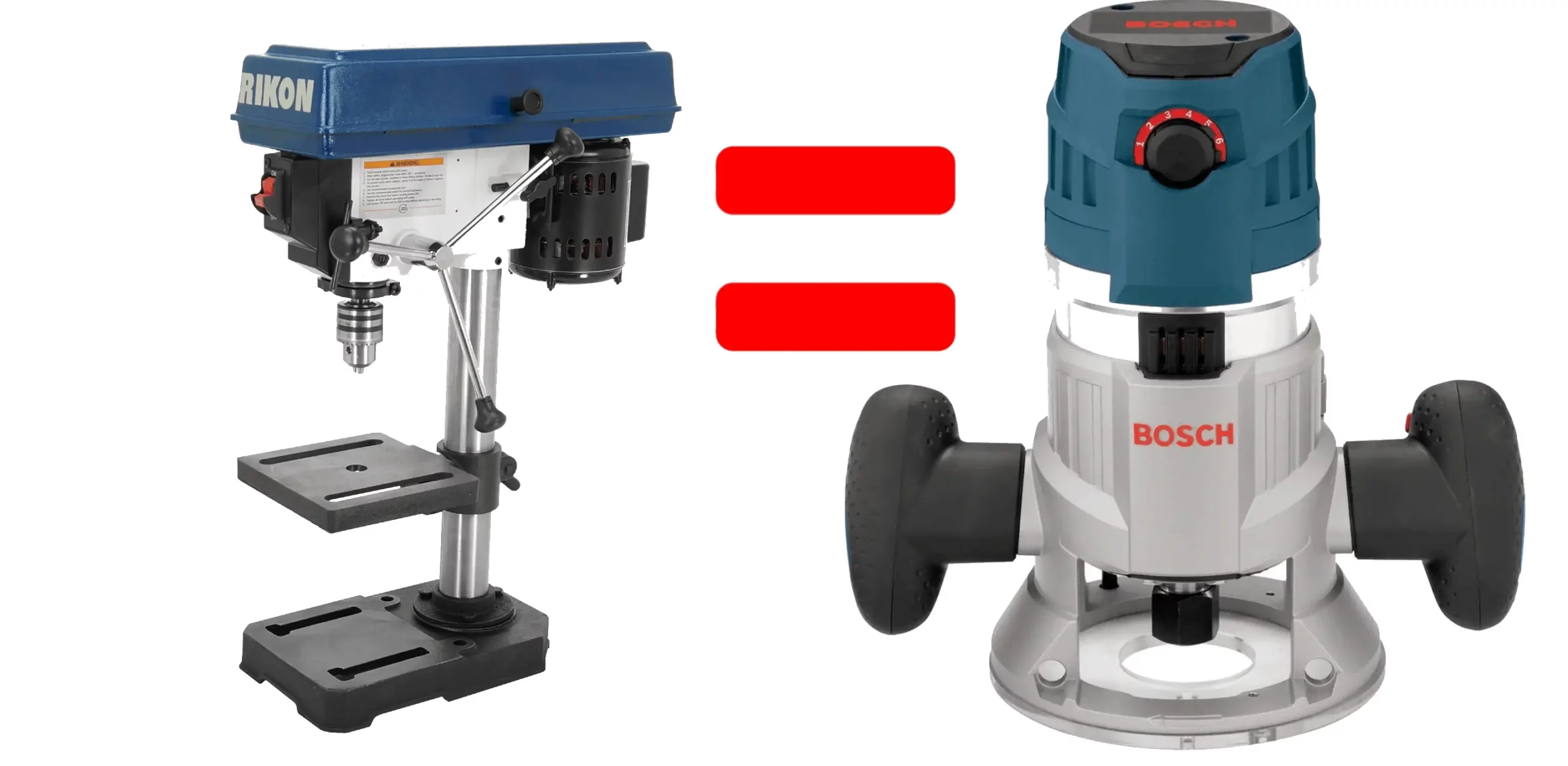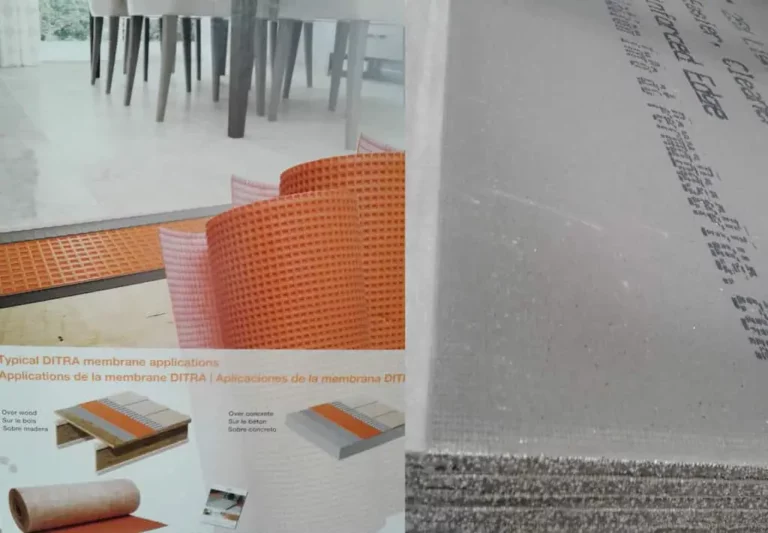Can You Use a Drill Press as a Router?

Both routers and drills operate by spinning a bit, which is why many believe they are interchangeable. You might be able to merge their functions using the proper procedures. But can you use a drill press as a router?
You can use a drill press as a router by adding a wooden surface. Additionally, you may use a router in the same way that you would a drill, by diving into the workpiece to create holes. You would need to devise a method for securely holding the medium in place for each machine in both instances.
The purpose of this post is to demonstrate how to convert a drill press into a router and vice versa. I’ll also explain their differences, similarities, and how to operate each piece of equipment for the other’s purpose.
How To Convert a Drill Press Into a Router
To begin, unplug your drill press from its power supply. Then, firmly grip the housing of the instrument and pull it upward. You’ll have to tilt it all the way back if it has a hinge.
You’re looking for the pulleys and belts.
The belt will pass through several sets of pulleys. To raise the drill press’s speed to function as a router properly, you must transfer this belt to the highest collection of pulleys.
Following that, add the wooden slab and follow these procedures:
- Secure the casing of the drill press.
- Adjust the knob as necessary.
- In the drill bit’s chuck, insert and tighten a bullnose router bit.
- Add hardwood at least ¾ in. (1.91 cm.) thick to your movable table.
- Lift the drill press table until the router’s center meets the edge of the wood you’re cutting.
While using your customized equipment, keep the following safety precautions in mind:
- Hold the working material in both hands.
- You must be cautious while dealing with high-speed router bits since they may be hazardous.
- Always use protective eyewear.
- Cordless drill press machines are best at low speeds.
The Disadvantages of Using a Drill Press as a Router
While you may want to increase the flexibility of your equipment, changing a drill press to a router has several performance disadvantages.
You should note that there is a kickback that occurs, which is always a problem when using a router bit due to the intense cutting action. However, the makeshift table saw helps to mitigate this impact.
But this is not the only hindrance to the drill press functioning well as a router.
The Decreased Speed Can Be Disadvantageous
A router operates at a speed of about 30,000 revolutions per minute. In contrast, a drill press runs at a maximum rate of approximately 2,000 rpm.
Router bits are developed especially for routers that operate at faster speeds.
If your drill press continues to run slowly after tightening the belts, this will result in the blades of the bit digging into the wood harshly. This may have some negative consequences, so you should bear this in mind before making the modifications.
There’s a Higher Chance of Damaging Your Bit
A drill chuck does not securely retain the bit as a router does. Therefore, it is more probable that the bit will slide. Frequent shifting will result in a sequence of cuts along the shaft of the bit, which alter the bit’s structure, rendering it unsuitable with the drill press and router.
You Can Break Your Drill Press
Because a drill press is made for downward motion, using it as a router may damage its gears. Additionally, applying extreme horizontal force can cause a chuck to come loose, rendering it useless or a threat.
For Use, You Need a Stable Base
A router needs a sturdy base to allow for precise control of the cut depth, and a drill press is not equipped with a depth control mechanism. Apart from this, drill chucks are incapable of properly holding router bits.
However, if the drill press is appropriately configured, it can be used as a router.
Specific drill presses are equipped with sturdy base and control systems. Additionally, some drills can become an overhead router by increasing the speed. The distinct belt configurations of these drills serve to identify them.
When To Use a Drill Press and When To Use a Router?
When your woodworking plans specify the placement of holes, you’ll need to use a drill press. Activities such as routing the edges or cutting dados and rabbets become much simpler when using a router. A drill press is excellent if your project needs Dowling or mortise cutting.
If you find yourself confused about which one to use, and when, you might need to check your owner’s manual about how to use a drill press and/or a router.
What Are the Differences Between a Drill Press and a Router?
A drill press creates holes, while a router is used chiefly to trim materials. Given their intended uses, a router spins considerably faster than a drill bit. A drill press may simulate the performance of a router, so you may want to examine the similarities and differences between the two.
How to Use a Router as a Drill Press
You can use a router to drill holes into material that is too big for the drill press or any of your other jigs. Here’s how to do that:
- Construct a self-centering jig using a hardboard and two wood fences spaced to correspond to the thickness of the workpiece to be drilled.
- Insert the jig into the subbase of your router, with the bit centered between the two fences.
- Equip your router with a plunging bit.
- Clamp the working material between the fences and begin drilling.
- Remember to pause to remove debris periodically.
How To Turn A Drill Into a Router
If you’re not having much luck turning your drill press into a router, you may be able to get away with transforming a hand drill into one instead. A drill plunge router accessory converts your press into an efficient router capable of creating ornamental edges, cutting straight holes, and freehand routing.
However, there are methods to construct a router attachment for your press at home. You can create this attachment by following the instructions below:
- Cut two 7.48” (19 cm) long pieces of 6” × 5” (15.24 cm X 12.7 cm) plywood.
- With a hole saw cutter, drill a 1 ½” (3.81 cm) hole in each plywood piece.
- Sand the plywood pieces’ corners until they are rounded.
- Use an adhesive to adhere square blocks on both sides of one plywood panel.
- Drill holes in these square pieces to a depth of 3.94” (10cm).
- Bolts that are 3.94” (10 cm) in diameter should be inserted through these holes and secured with an adhesive.
- Make a straight cut from the center of the gap to the end of the plywood without the square attachments. The finished product should resemble a lollipop.
- Make another cut halfway between the straight line starting at the outer edge. You should cut each side of the wood at 90° to create a T-shaped piece.
- Drill 4.72” (12 cm) holes on both sides and glue a steel pipe that is 7.48” (19 cm) in length into each of these holes.
- Add two springs on the plywood base.
- Attach 3.94” (10 cm) nuts to two circular plywood panels that are 1 ½” (3.81 cm) in diameter.
- Attach two 5” (12.7 cm) long screws with nuts to the drill holder plywood piece. You will use these screws to secure the drill machine’s position.
- Through the 1 ½” (3.81 cm) hole, secure a drill machine with a bolt and fly nut.
This YouTube video will teach you how to make a wooden router attachment for a drill machine.
Final Thoughts
Many individuals who have attempted to convert their drill press to a router say that it is a difficult process whose results often fall short of expectations. However, if your drill press is configured to work as a router or with router bits, you may definitely proceed.
If you’re still unsure how to begin the transformation, Diamleon DIY Vids offers a video guide for you:






